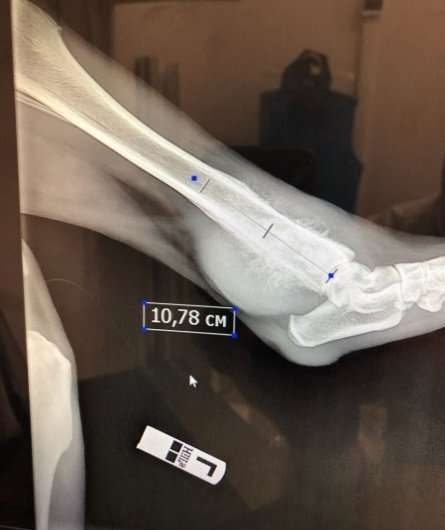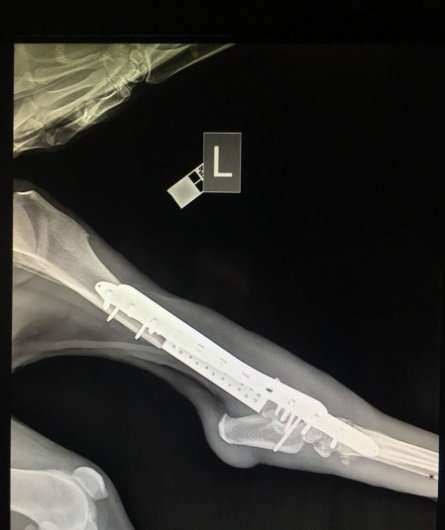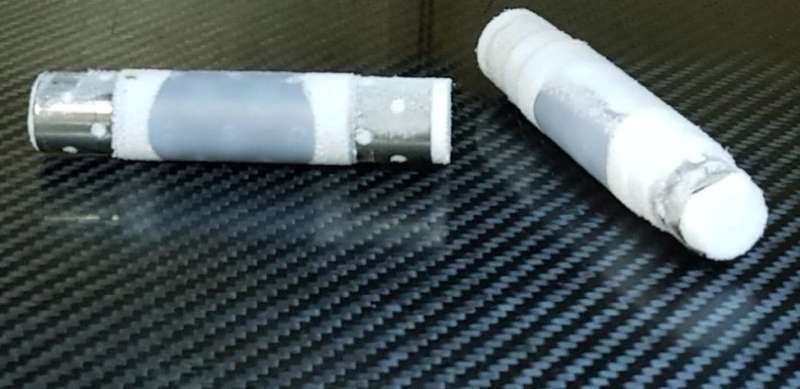Scientists successfully implant a polymeric prosthesis imitating bone structure

For the first time ever, a research team from the small innovative enterprise Biomimetix, implementing several NUST MISIS developments, has successfully implanted a biomimetic hybrid prosthesis-imitating bone structure made from ultra-high molecular weight polyethylene and titanium alloy into a patient's femoral bone. The successful surgery was carried out at the request of the MedVet veterinary clinic.
The operation, which aimed to implant an experimental biomimetic (similar in structure to the tissues of a living organism) prothesis into a dog with osteosarcoma of the femur, was successfully carried out in August 2018. In just a few days, the animal was again able to walk, and, according to forecasts, its mobility will fully be restored within the next few months.
Osteosarcoma (osteogenic sarcoma) is a fast-growing cancer whose cells originate from bone tissue, leading to its gradual destruction and, accordingly, the loss of mobility. Osteosarcoma is the most common type of bone tumor in both humans and animals.
Treatment for the disease includes a course of chemotherapy and surgery to remove the affected tissues. Advanced technologies allow for organ-preserving surgery, and to support the affected bones, doctors usually insert a metal, ceramic or polymer implant into the bone. Despite the fact that prostheses can restore mobility, they are very different in structure from bone tissue, and this can lead to a number of significant difficulties.

"The traditional materials for medical prosthetics have a number of significant disadvantages: for example, titanium implants take on too much of the load intended for the bone, and the latter begins to thin out. In this situation, the bone at the junction with the prosthesis may break. Another option is ceramics, but they are more fragile, which may limit the size of the recovered bone tissue. In addition, the structure of these materials does not allow them to "grow together" with the bone—a constant tight fixation is required," explained Fedor Senatov, general director of Biomimetix and research assistant at the NUST MISIS Center of Composite Materials.
The Biomimetix team has been engaged in the development of biomimetic implants for several years. Scientists work with ultra-high molecular weight polyethylene—proven biocompatible materials, but they modify the materials in a unique way that gives the implants the necessary structure. This is the world`s first example of creating biomimetic prostheses from a polymeric material like this. In August 2018, at the request of the MedVed veterinary center, the Biomimetix team developed an experimental biomimetic prosthesis for the femur of a dog with osteosarcoma.
"Since the dog was big, it used to move [very much], so 11 cm of bone was required to be removed, and the prosthesis [needed to be] a hybrid. On the titanium tube, made with 3-D printing by Konmet, our partners, we have increased the layer of solid ultrahigh molecular weight polyethylene, and the inner part is made of porous ultrahigh molecular weight polyethylene, identical to the structure of the spongy bone. During the operation, part of the coating was cut to "fit" the implant to the bone. A few days after the surgery, the dog was able to walk. If the fusion of the polymer and bone tissue is successful, it will be possible to remove the fixing plates after some time," said Senatov.

"We have successfully performed a prosthetic operation. The implant is durable, as it corresponds to the weight of the dog and the bone size. Here, the long-term results are more important so the implant is accustomed and rooted in the bone. We can expect [a lot of] progress, but it takes time. Now we are watching the dog as it undergoes chemotherapy," said Ilya Vilkovyskiy, head doctor at MedVet.
The Biomimetix team plans to continue working in the field of biomimetic prosthetics for veterinary use.
Provided by National University of Science and Technology MISIS




















